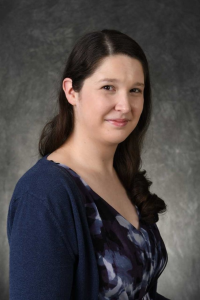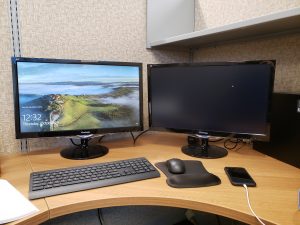What does life after the Brittain Fellowship look like? What opportunities within academia or in other sectors do Brittain Fellows pursue? And how does the postdoc prepare Brittain Fellows for these positions? The Professional Development Committee reached out to former Brittain Fellows to find out the answers to these questions and more. The interview below — featuring Andrea Krafft, an instructional designer and trainer, and a Brittain Fellow from 2015-2018 — is the second in a series of interviews with former Fellows about their professional lives and career trajectories. (Other interviews feature Brandy Simula, Rebecca Weaver, and Emily Kane). The interview has been lightly edited for clarity.

Former Brittain Fellow Andrea Krafft now works as an instructional designer and trainer.
What years were you a Brittain Fellow/what institution did you come from?
I was a Brittain Fellow from August 2015 through July 2018. During 2016-2017, I was the assessment coordinator for WCP. From 2017-2018, I was the assistant director of WCP. Prior to becoming a Britt, I completed my Ph.D. at the University of Florida.
What is your job now, and what does your daily workday look like?
I recently left a tenure-track position at Abraham Baldwin Agricultural College to become an instructional designer and trainer in the IT department of Tokio Marine Stop Loss Group. I started my position in July of this year. My main role is to provide training to help the employees of the Stop Loss Group understand the technology they use to complete their jobs.
For example, I’ve made training about video conference best practices, Microsoft Teams, and Excel, to name a few. Since COVID-19 increased the need for remote work, I create my training primarily as self-paced videos, so I spend a lot of time writing scripts, developing training guides, recording videos, editing, and organizing things into Microsoft Stream and SharePoint. I also sometimes lead “live online” training sessions using Microsoft Teams and answer one-on-one calls or emails for assistance with software (especially Excel, since our business is primarily based on medical stop loss claims, underwriting, and so on). When it’s safe to do so, I’ll also lead classes in our dedicated training room, which is a computer classroom with a divider wall (a lot like the classroom upstairs in Hall). I’m part of a small “docs and training team,” so I also do work involving user guides and update our SharePoint intranet site in terms of content and visual design.
What was your path to your current position? What sort of contacts or experiences were helpful to securing that job?
After March created so many sudden and unexpected changes in all of our lives, I rethought my academic career path and decided to explore corporate positions. I initially explored jobs in technical writing and, while conducting research, learned more about positions in instructional design (or ID). Honestly, I wish I had heard more about ID during grad school and even college — it’s such a fascinating and huge field! I spent a long time retooling my academic CV into a skills-based resume, which [former Brittain Fellow] Chelsea Bullock covered during a visiting talk I attended as a Britt. I also joined a Facebook group about instructional design, took as many LinkedIn Learning courses as I could about software and skills relevant to this industry, and updated my professional website to become more portfolio based. Understanding multimodal principles helps a lot when you’re trying to create a professional brand!

Andrea Krafft’s workspace
How have you transferred the skills that you developed as a Brittain fellow to your present position? Of the skills that you developed as a fellow, which have become most valuable to you?
Having a lot of experience in the classroom on top of having to articulate my teaching philosophy carried over well to the small set of interviews that I had. Being on the Brittain Fellow hiring committee definitely helped me better understand more about the interview process. I also think discussing pedagogy theories (Bloom’s taxonomy, for example), translated well into my current position (since theories of learning underlie the instructional design process). My time as assessment coordinator was also useful in a lot of ways to my current job, since I better understand how to not only set but also measure learning objectives.
What Brittain Fellow opportunities (teaching, research, service) were especially valuable to you? Is there anything you wish you’d done or done more of?
I think I addressed this a bit in my previous answer, but being a member of and then the chair of the assessment committee was hugely useful. Within and outside the academy, knowing how to measure learning and then apply that feedback loop to improve pedagogy (or andragogy) is invaluable. Developing multimodal assignments helped me to expand my own skill set in terms of audio editing, video production, infographic design, and more.
What led you to ID over a tenure track position?
I don’t have a simple answer to that question because so many factors led to my decision. Also, I would never presume to offer blanket advice to anyone who’s thinking about leaving academia for other paths, and I strongly dislike the entire genre of “quit-lit” think pieces. At the end of the day, a tenure track position is a job that has its pros and cons. I specifically chose ID because I wanted to still be in a career where I could do what I love most: teaching, interacting with learners, exploring innovative methods of multimodal communication and, in the process, learning new ways to convey information. I really enjoy the tight-knit team that I’m in now, and every day has presented new opportunities to practice and expand my skills.
